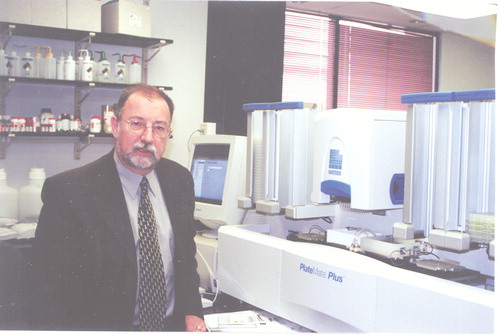Companies Race to Find Mental Illness Genes
Two for-profit companies, one on the East Coast and the other on the West Coast, are working to identify the underlying genes that cause certain psychiatric disorders. The goal is to develop new drugs that will reverse the disease process.
Psychiatric Genomics Inc., housed along the biotechnology corridor of Gaithersburg, Md., a few miles north of Washington, D.C., is looking for the underlying genes that cause schizophrenia, bipolar disorder, and autism.
 President and Chief Executive Officer
President and Chief Executive Officer
The study of genes and how they function in disorders was facilitated by the completion of the human genome map last fall.
Advances in computer technology and molecular biology have made mining genetic data much more efficient. DNA information from families with psychiatric disorders is stored on thumbnail-sized, silicon computer chips and rapidly scanned by researchers.
Scientists look for links between genetic markers and the disease. They then compare the DNA structure of a suspect gene with the structure of a gene from a healthy individual. To understand how the gene works, they analyze its chemical structure and identify what it produces—for example, a neurotransmitter or an enzyme. Once the chemical product is identified, researchers can begin developing drug compounds that alter the genetic process, according to Palfreyman.
“We have a rational approach to discovering drug candidates compared with the last century when drug discoveries for mental illness were made primarily by serendipity,” said Palfreyman.
For example, a finding that led to the discovery of the first antidepressant occurred about 50 years ago when a physician noticed that patients being treated for tuberculosis with certain drugs experienced striking improvements in their mood, according to Palfreyman.
The reason for using live tissue from rats or mice is that postmortem tissue from psychiatric patients is hard to come by and may be of insufficient quality for analysis, Nikolich told Psychiatric News.
“The postmortem samples also don’t allow researchers the opportunity to measure how the disease progresses over time,” added Nikolich, a Hungarian-born research scientist. The word “agy” in AGY Therapeutics means “brain” in Hungarian.
Moreover, reports on genetic mapping released last month indicate that human beings have only slightly more genes than rodents, said Nikolich.
To get tissue samples from “depressed” rats, for example, researchers at AGY Therapeutics expose the rodents to a continuous regimen of stressful conditions, including sleep and food deprivation.
“Once the rats are depressed, we take tissue samples at several points in time and develop genetic markers representing the early stages of the disease. Then we can develop tests to diagnose the disease and screen drug compounds against the proteins produced by these genes,” said Nikolich.
Like Psychiatric Genomics, AGY Therapeutics is using high-tech machines that can screen thousands of drug compounds simultaneously against complete genetic pathways with the goal of targeting the root cause of a disorder, not just the symptoms.
Nikolich is negotiating with large pharmaceutical companies to fund the development of diagnostic tools, promising drug molecules, and ultimately clinical trials.
Nikolich anticipates that clinical testing in human beings for new diagnostic tests for depression and schizophrenia could begin in one to two years. Clinical testing for drug compounds to treat depression and schizophrenia could begin in one to four years, said Nikolich.
The company is using the same process as Psychiatric Genomics in analyzing animal genes and their products. It has already begun testing drug compounds to determine which compounds interfere in a defective gene’s cellular expression.
Psychiatric Genomic’s primary investor, Oxford Bioscience Partners, is banking on its approach to genetic discoveries to find new drug candidates.
Chairman
A sister company, Avalon Pharmaceuticals, also birthed by Walton and housed in the same building as Psychiatric Genomics, is using a similar process to find drugs to treat cancer genes. “We had a breakthrough recently when we found that certain drug compounds reversed the disease process by causing malfunctioning cells to function normally,” said Walton.
He is hoping for a similar breakthrough with Psychiatric Genomics. Palfreyman cautioned, “Even with cutting-edge technology, we are still dealing with complex disorders involving multiple genetic mutations and the environment.”
He estimates that if his company’s efforts succeed, new drugs for schizophrenia, autism, and bipolar disorder could reach the marketplace in about 12 years.
Palfreyman hopes to interest pharmaceutical companies in manufacturing the candidate drugs and funding expensive multicenter clinical trials needed to test these drugs before they can submit them for approval to the Food and Drug Administration. “We really don’t know how well the drugs will work until we test them in human beings.” ▪



